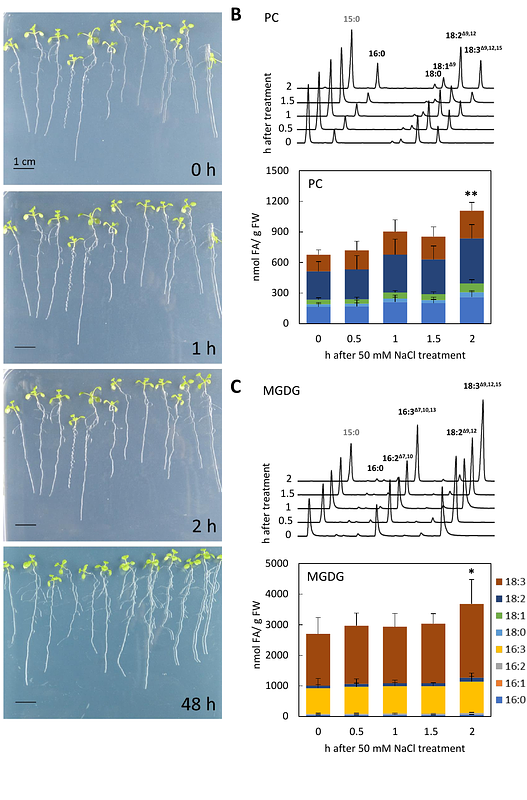Inter-Organellar Effects of Defective ER-localized Linolenic Acid Formation on Thylakoid Lipid Composition and Xanthophyll-Cycle Pigment De-epoxidation in the Arabidopsis fad3 mutant

Inter-Organellar Effects of Defective ER-localized Linolenic Acid Formation on Thylakoid Lipid Composition and Xanthophyll-Cycle Pigment De-epoxidation in the Arabidopsis fad3 mutant
Matzner, M.; Launhardt, L.; Barth, O.; Humbeck, K.; Goss, R.; Heilmann, I.
AbstractMonogalactosyldiacylglycerol (MGDG) is the main lipid constituent of thylakoids and a structural component of photosystems and photosynthesis-related proteo-lipid complexes in green tissues. Previously reported changes in MGDG abundance upon stress-treatments are hypothesized to reflect mobilization of MGDG-based polyunsaturated lipid intermediates to maintain extraplastidial membrane integrity. While exchange of lipid intermediates between compartmental membranes is well documented, physiological consequences of mobilizing an essential thylakoid lipid, such as MGDG, for an alternative purpose are not well understood. Arabidopsis seedlings exposed to mild (50 mM) salt-treatment displayed significantly increased abundance of both MGDG and the extraplastidial lipid, phosphatidylcholine (PC). Interestingly, similar increases in MGDG and PC were observed in Arabidopsis fad3 mutant seedlings defective in ER-localized linolenic acid formation, in which compensatory plastid-to-ER-directed mobilization of linolenic acid-containing intermediates takes place. The postulated (salt) or evident (fad3) plastid-ER-exchange of intermediates concurred with altered thylakoid function according to parameters of photosynthetic performance. While salt-treatment of wild type seedlings inhibited photosynthetic parameters in a dose-dependent manner, interestingly the fad3 mutant did not show overall reduced photosynthetic quantum yield. By contrast, we observed a reduction specifically of non-photochemical quenching (NPQ) under high light, representing only part of observed salt effects. The decreased NPQ in the fad3 mutant was accompanied by reduced activity of the xanthophyll cycle, leading to a reduced concentration of the NPQ-effective pigment zeaxanthin. The findings suggest that altered ER-located fatty acid unsaturation and ensuing inter-organellar compensation impacts on aspects of thylakoids related to the function of specific enzymes, rather than globally affecting thylakoid function.